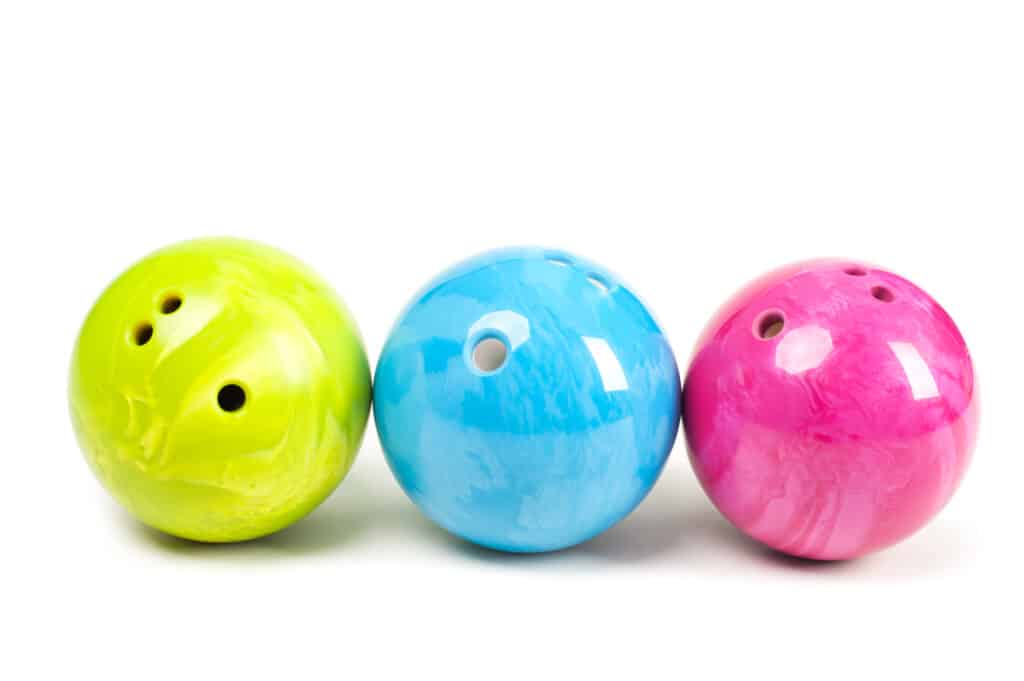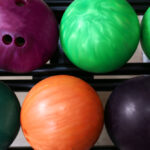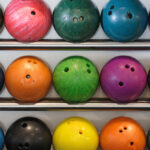
Let us pose a quick scenario to you: you’ve just joined a hockey team, it’s the first practice, and as a beginner, you need ice skates in order to start.
A teammate tells you they have an extra pair and hands you a pair of skates that are three sizes too small.
Confused, you look around and see everyone forcing their feet into the same-sized skate, regardless of their different needs and sizes.
When you bring this weird issue to your teammate’s attention, they merely shrug and say, “One size fits all.”
It doesn’t sound quite right, does it? Unfortunately, this is a common misconception that many beginner bowlers unknowingly fall into as they choose their bowling ball size and weight.
Many bowlers believe that one size of bowling ball does fit all and that this universal sizing is the heaviest ball you can possibly throw.
Now, we don’t know about you, but we certainly cringe at the thought of shoving our feet into skates that are three sizes too small and playing hockey in them.
So why should you force yourself to use a wrong-sized bowling ball to bowl?
The bowling ball is perhaps the most important piece of equipment you need to play bowling successfully, and having the right fit for sizing will do your game wonders.
As we mentioned before, there seems to be this false belief that you should be throwing with the heaviest ball, no matter what.
While throwing with a heavyweight can indeed be a goal, you need to make sure that you are using a weight that is comfortable for your body and working your way up to heavier weights, not just starting with them right off the bat.
Contents
- 1 What Is the Heaviest Legal Bowling Ball Size for League Bowling?
- 2 Why Does Bowling Ball Size Weight Matter?
- 3 When Do You Know You Need to Change Your Bowling Ball Weight?
- 4 How Heavy Should Your Bowling Ball Be? How to Know Your Ball Is Too Heavy.
- 5 How to Know Your Ball Is Too Light
- 6 Is There a Difference Between House Balls and Personally Drilled Balls?
- 7 What Is Your Ideal Weight?
- 8 Other Bowling Balls and Their Weight
- 9 How do You Find Your Ideal Weight?
What Is the Heaviest Legal Bowling Ball Size for League Bowling?
The heaviest legal ball you can use in bowling is a sixteen-pound ball, per USBC specifications and while some individuals may start off with this ball (which is great), others need to start with a ball that suits their body’s needs and work their way up to a heavier weight.
The more popular weights for adult bowlers tend to range between 10 to 15 pounds, with male averages coming in at 14 to 16 pounds and females averaging around 10 to 14 pounds.
Why Does Bowling Ball Size Weight Matter?
Having the right weight will allow you to throw consistent speeds that provide more pin action.
For example, if your ball is too heavy, you will slowly but surely lose speed as practice progresses, and your body is weighed down by the ball.
If your ball is too light, you will lose possible points from the lack of force you could be having with a heavier ball.
Having a heavier ball is always the goal since the impact of the ball is dependent on speed times mass. You also want the weight that works best for you because of that speed factor.
If you can only throw high speeds at the beginning of practice with a heavier ball and then lose speed, you are better off switching to a lower weighted ball where you can keep your speeds consistent.
So if you can only throw a 16-pound ball at 10 mph as you practice (16x10=160), you would be better off with a 14-pound ball at 18 mph (14x18=252) for greater impact.
When Do You Know You Need to Change Your Bowling Ball Weight?
Knowing when you need to change your bowling ball weight is key to elevating your game and gaining consistent, predictable bowling.
Using a ball that is too heavy for you, you run the risk of injury or loss of stamina.
Use a ball that is too light, and you decrease your pin impact and potential scores.
Having a balance and knowing what to look for in either scenario will help you know when it is time to drop down a few pounds or go up a pound.
How Heavy Should Your Bowling Ball Be? How to Know Your Ball Is Too Heavy.
The biggest indicator that you are using a bowling ball that is too heavy for you is your own body.
Are you going home and waking up with sore muscles after bowling practice?
Do your joints creak in protest or seem stiff and achy? Do you have back pain, shoulder pain, elbow pain, arm pain, or wrist pain that flares up, especially after a night of bowling?
Do you notice that the speed of your bowling ball drastically drops as you play more games, and your arm doesn’t have enough stamina to maintain consistent strong throws?
If you answered yes to any of these questions, then chances are you are bowling with a ball that is too heavy for you.
Bowling with a heavy bowling ball can be great for your game, and working towards heavier weights is definitely a goal you want to strive for.
However, if you are injuring your body by using a heavy ball that you are not ready for, you are actually hurting your chances of getting to a point where you can use that ball comfortably.
The constant strain your muscles and joints undertake as they try to withstand a weight that they haven’t properly been prepared for can cause serious injury.
Even with preventive measures, such as stretches and braces, you can still tear, pull or sprain your joints and muscles.
You would not begin strength training by attempting to deadlift one hundred bounds; bowling should be no different.
Listen to your body and work your way up the weights, keeping yourself at a comfortable level that doesn’t leave you sore and aching.
Benefits and Drawbacks of Heavy Bowling Balls
| Benefits | Drawbacks |
| A bowler has less control with heavy balls than with light bowling balls | They tend to be more expensive than lightweight balls. |
| They're less forgiving if you don't hit the pins dead-on. | Heavyweight balls are more difficult to throw and can cause arm strain. |
| It is easier to create a larger hook with a heavier bowling ball. | You’re likely to get tired of bowling with heavy balls. |
| Have less deflection as it goes through the pins. | A bowler has less control with heavy balls than with light bowling balls |
How to Know Your Ball Is Too Light
If throwing your bowling ball feels consistently easy, then it might be time to move up a weight level.
Your goal should always be to (safely) move up in weight in bowling balls due to the force increase it provides you.
If your ball is feeling easily thrown or you find yourself maybe catching a lot of air as you throw it, then you have good indicators that you should try the next weight level up.
Try using a house ball with the next weight size up for a few practices and see how it changes your game.
If you are throwing well with minimal soreness, you should be good at looking for your own ball of that weight.
Benefits and Drawbacks of Lightweight Bowling Balls
| Benefits | Drawbacks |
| Are made from softer materials like rubber making them light for both kids and adults. | Are made from softer materials like rubber, making them light for both kids and adults. |
| Less expensive compared to heavyweight balls. | It’s challenging to achieve the perfect ball deflection. |
| They’re not as durable as heavier balls and may need to be replaced more frequently | Requires more speed and momentum to achieve the same results as a heavier ball. |
| They're more likely to hook or split if you don't hit the pins perfectly |
Is There a Difference Between House Balls and Personally Drilled Balls?
Ask any expert bowler, and they will tell you that using a house ball versus a ball drilled especially for you makes a huge difference.
When you use a ball tailored to fit your needs, it helps distribute the weight better, gives you a more solid grip, and helps you control the action of the ball better.
Many bowlers have claimed that they can use bowling balls up to two pounds heavier when comparing their custom-made grip bowling balls to house balls.
House bowling balls are drilled to fit varying finger sizes and grip types and are, therefore, more general in the support and grip they can offer you.
While house balls are great with preliminary tests to find the right weight for you, if you intend to take bowling seriously, then you should look into getting a custom-made ball.
The difference your personal grip will make for your weight limit will help your score a great deal.
What Is Your Ideal Weight?
So, what exactly is your ideal weight? We’ve talked about how to know if you are using a ball that is too heavy and if you are using a ball that is too light, but when do you know that you have found a ball that is just right?
The goal of any serious bowler is to find a ball weight that can be your go-to ball, one that gives you a great amount of reaction, control, and predictability as you use it throughout the night.
Most importantly, the ball needs to be at a weight that doesn’t physically wear you down as you progress with games.
As we mentioned before, heavy bowling balls decrease your stamina throughout the night and tire out your muscles quicker, resulting in a loss of speed, control, and aim.
You also want to avoid a light ball as well so you can score a higher number of points per game, resulting in the need for a middle-ground ball.
The ideal weight for your ball should provide enough weight that you are able to generate a good amount of force with it while preserving your speed and stamina as you bowl through the night.
You want a ball that keeps you at a level of comfort and doesn’t strain your muscles and joints as you use it for an extended period of time, whether it is one night of practice or throughout a whole season.
House bowling balls are a great way to narrow down your zone of comfort without spending too much money.
Just remember that there is a notable difference between house ball weights and personalized ball weights.
Other Bowling Balls and Their Weight
Bowling balls vary depending on the type of game you’re playing.
Ten Pin Bowling- is widely known, and it’s what you think about when someone mentions bowling.
Ten Pin balls are typically performance or non-performance balls with 3 finger holes.
According to the USBS specifications, the ball can be as light as a feather and up to 16 lbs.
Duck Pin Bowling- is slightly different in pin shape/size and ball than the Ten Pin bowling specifications.
Duck Pin bowling balls weigh between 3lbs 6oz and 3lbs 12oz, and it’s fingerless, with no holes.
Candle Pin Bowling- is similar to Duck Pin Bowling.
The Candlepin bowling balls are smaller balls, have no holes, and have a max weight of 2lbs 7oz.
How do You Find Your Ideal Weight?
So now that you know how to recognize the different ways your body can respond to weight types, how do you go about finding your ideal weight?
Well, you could take the long road and search for it through experimentation, trying each ball type for several days and working through the ranks in a long, drawn-out process.
Or, you could just use a method that helps you locate the proper weight for your bowling ball and work up from there, stopping at your body’s comfort level.
If you really want to go with the trial-and-error method, go right ahead; it could be a lot of fun!
However, just to be safe, you may want to read the method most bowlers use to find their starting weight.
The process of finding the right starting weight for you in bowling really comes down to a simple math equation.
You take your body weight in pounds and divide it by eleven, rounding to the nearest whole number. That’s it!
Once you have your starting number, it is usually a good idea to even start a few pounds lighter than that number and work your way up to heavier weights based on your body.
For example, say that you weigh one hundred and fifty pounds.
In order to find your starting weight, you take 150 and divide it by 11, getting an answer of 13.63.
Since we are rounding to the nearest whole number, the starting weight of your ball would be fourteen, but you should start with a 13 or 12 and work your way up to a 14 over the course of practice to make sure it is the right fit for you.
So now that we’ve discussed why the right weight in your bowling ball is important, how to recognize that you need to change your bowling ball weight, and how to find the ideal weight for you to use when bowling, we hope you take these skills out into the bowling world and put them in to practice.
Be patient as you experiment with different weights.
This is an ever-learning, evolving process. As you get stronger, your bowling weight may change and grow heavier, or you might reach an equilibrium of weight.
Both options are good as long as you remember that consistent speed is the key.
What Do Bowling Ball Sizes Mean?
Bowling ball sizes refer to the weight of the ball, not its dimensions, which are universal. The weight can vary, starting as light as 6 lbs and reaching a maximum of 16 lbs. Choosing the right weight is crucial for a bowler's performance and comfort. Many adult bowlers often prefer weights around 14 to 15 lbs. The correct weight helps maintain control, accuracy, and consistency in the game.
How Do I Know What Weight Bowling Ball I Need?

Generally, the 10% rule is used. The 10 percent rule of thumb states a bowler should bowl with a bowling ball that's 10% of their body's weight. For instance, if you are 120 lbs, you should bowl with a 12-pound ball. If you are 140 lbs, you should bowl with a 14-pound ball.
Is It Better to Bowl With a Heavier Ball
Using a heavier ball has its pros and cons. While it can lead to better pin action and less deflection, it's not always the best choice for everyone. A ball that's too heavy can be difficult to control and might lead to strain or injury. Bowlers must select a weight that complements their physical strength and skill level, ensuring safety and optimal performance. The goal is to find that sweet spot where the ball's weight enhances your game without causing discomfort or strain.
How Do You Know If Your Ball Is Too Heavy?

Immediate discomfort and/or pain and poor form.
The weight of the ball should be evenly distributed in your hand. If the ball feels top-heavy or off-balance, it is likely too heavy for you. Your arm should be comfortably extended when you bowl. If you have to reach or strain to throw the ball, it is probably too heavy.
Watch your form. If you find yourself clutching the ball tightly or tensing up when you swing, the weight of the ball may be too much for you. Lastly, listen to your body. If your back, arm, or shoulder starts to hurt after bowling a few games, the ball is likely too heavy.
How Do I Choose a Bowling Ball at the Alley?

By the fitting of the finger holes and weight. Choosing a bowling ball from the alley is convenient for new bowlers who haven't purchased a customized ball. Unlike customized balls, house balls are not drilled for your specific hand span and finger sizes.
So when choosing a bowling ball at the alley, it's important to choose a ball that allows your fingers to comfortably enter and pull out of the holes effortlessly and maintain a secure grip. In addition, the bowling ball should be the ideal comfortable weight (not too heavy and not too light).
Related Articles
- What Fingers Do You Use to Bowl
- Bowling Lane Oil Patterns
- How to Throw a Bowling Ball Faster
- Best Bowling Shoes for Sliding
Having a strong, consistent speed will help you generate more force at the point of pin impact, gaining you better results in your scoring.
It is also important to remember throughout this process that you need to listen to your body. Overextending your limits as you work to find your bowling ball weight can lead to strains, tears, sprains, and other related injuries.
Don’t be afraid to take it easy and enjoy the process of finding your ideal bowling ball weight. Consider it an adventure in your journey to becoming a better bowler!
Kira Byrd, a Certified Fraud Examiner, holds a B.S. in Accounting from the University of Alabama at Birmingham. With a passion for bowling from her childhood, Kira has poured her expertise and personal experiences into creating and nurturing Bowling For Beginners. Kira's mission is to meet new bowlers where they are and guide them toward consistently achieving higher scores. With a focus on skill development and strategic techniques, she empowers readers to take control of their game and unlock their true potential.
Bowling For Beginners embodies strict editorial integrity, ensuring reliable and unbiased information. Kira's commitment to delivering valuable insights and practical strategies is reflected in every article. Here's an explanation of our editorial policy and how we get money.





